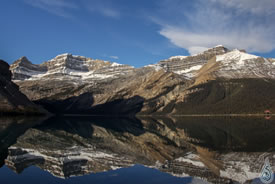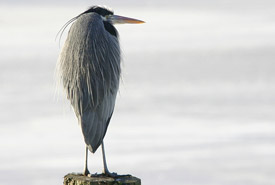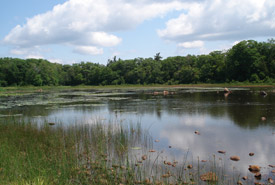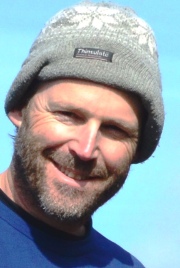Nature-based solutions for an uncertain future

Bow Lake, AB (Photo by Sarah Boon)
Here in Canada, it’s a luxury to not think about water. Most of us watch it come out of the tap and go down the drain without considering its source or destination. But many people in the world don’t have taps or drains. In fact, over 1.2 billion people experience critical water shortages. They think about water every day.
Climate change requires that Canadians change how we think about water. It has weather and water scientists scratching their heads as precipitation patterns shift, and we prepare for conditions we may not have seen in our lifetime. While there are things we don’t know about climate change — for example, exactly what the temperature will be in my town 20 years from now — some things are more certain.

Great blue heron (Photo by Bill Hubick)
Canada has warmed about 1.5 degrees over the last 60 years, with most of that warming occurring in the winter and spring and in the west and the north. Climate change has also altered how, where and when we receive rain and snow. There is more variation in rainfall amounts, with some regions getting a lot more and some a lot less. The extent of our seasonal snowcover has decreased, with areas in the south seeing fewer days with snow. We are also seeing more extreme rain events, with a month’s worth of rain falling in just a few hours.
It can be difficult to see how an international report like the one from the IPCC relates to our everyday lives, until we look more closely at what water means for Canadians, and how it’s affected by human activities.
My kids occasionally think about water when the pump in our well stops working. My brother-in-law is a farmer in southern Ontario, so he thinks a lot about rain and soil moisture; grain farmers in western Canada probably think about it even more than he does. My friends who like to canoe think about how much water we have in rivers and lakes. People who work for municipalities think about how much water remains in wells and reservoirs, and how to get people to stop watering their grass. But most of us, when we think about water, think only about where the nearest tap is.
Unfortunately, it sometimes takes a disaster to make us rethink our relationship with water, and water has some very effective ways of communicating with people. The extreme rains that were predicted by climate change scientists are the same rains that lead to extreme pulses of sediment and nutrients from the land and sometimes cause devastating floods. These events were once very rare, but have become almost a regular occurrence in some places. My kids have already lived through several hundred-year storm events where we live. Floods, drought, and dirty water that makes people sick, send a strong message.
To adapt to our new climate, we need to change our relationship with water and the landscape. For over 200 years in North America, we have tried to move water off the landscape as quickly as possible. It seems amazing that over a century ago, settlers and engineers toiled to drain land under the slow but persistent efforts of horse and steam. In places like Pelee Island and the Fraser Valley, these were amazing feats of engineering, vision and hard work. Along the south shore of Lake Erie, in an area formerly known as the Great Black Swamp, the International Drainage Hall of Fame is a testament to our efforts to move water off the land.

Sandy Island coastal wetland, Ontario (Photo by NCC)
However, draining the landscape causes profound changes in the water cycle. Instead of allowing water to slowly infiltrate into aquifers or streams, or meander through roots and stems to return to the atmosphere through leaves, we push water along hard, straight lines where the benefits of interacting with soil and plants are lost. Instead of water being purified, we have water that is contaminated with too many nutrients and other compounds. Instead of a gentle, steady release of water into stream, soil and air, we flush it quickly through waterways that rise and fall like a toilet being flushed.
How do nature-based solutions help reduce flood risks?
The role of natural processes in helping us to adapt to a changing climate is beginning to be appreciated. In places where we’ve removed those processes from the equation of people, land and water, we see more floods and dirty water. Retaining and restoring wetlands and floodplains is a critical part of our adaption to climate change. Nature conservation actually provides a two-for-one return on investment when it comes to climate change: it increases landscape resilience to extreme weather (for example, by wetlands storing water to reduce floods), helps capture and store atmospheric carbon in conserved spaces.
While we need to use water and other natural resources (such as trees and land), there are ways to use those resources wisely and to offset unavoidable impacts. In the case of water, those offsets can include protecting wetlands and recharge areas. This actually creates an opportunity to leave a legacy of health and resilient water, land and people.
If we think about water a little more today, maybe future generations will need to think about it a little less.
This post originally appeared on Science Borealis.


